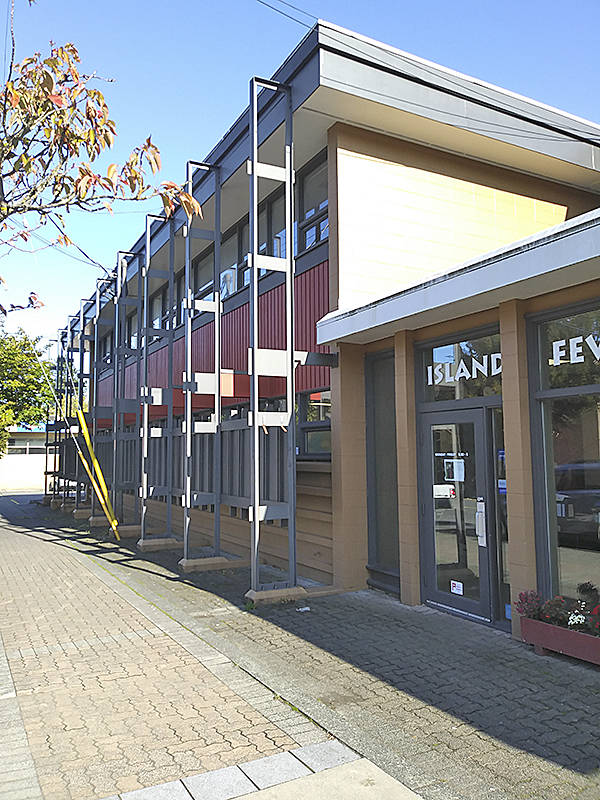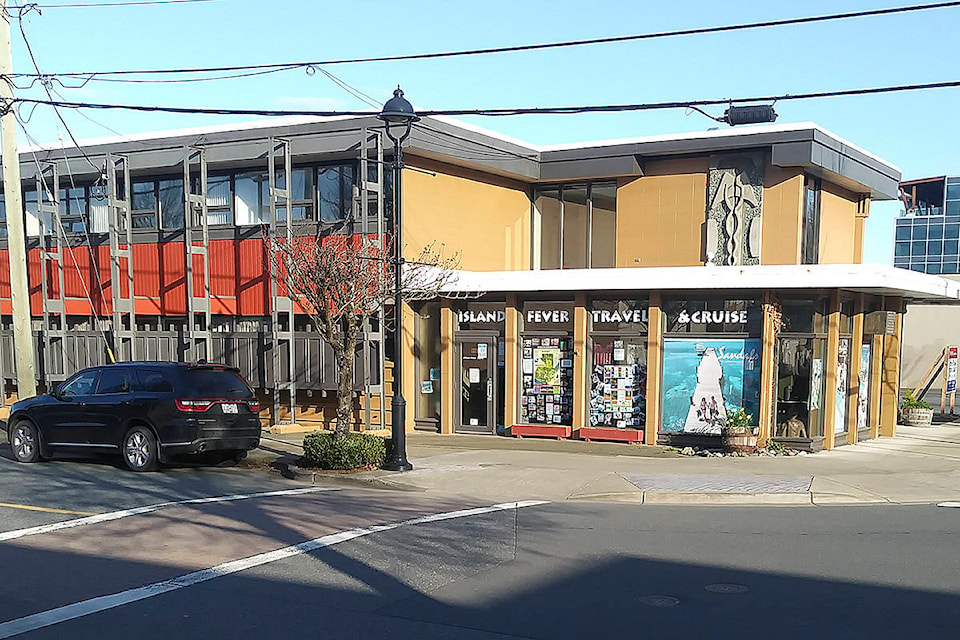By Morgan Ostler
Special to the Mirror
The most curious looking building in Campbell River, designed by the nationally recognized architect John Di Castri, has always attracted the bemused interest from passersby.
What catches their attention are a series of angle-steel posts that clad the north and south sides of this 56 year old former medical clinic.
It was 1964 when three young doctors purchased a piece of land on the edge of downtown Campbell River which was to be the location of their future Alder Medical Clinic. However, the gravelled land they had chosen so eagerly turned out to be not quite what they had expected.
It was located on the south-east edge of “Cod Fish Flats,” a spongy piece of tidal flat that stretched from the downtown area all the way to Nunn’s Creek, a half mile distance. On the day that work began on the site the doctors watched their contractor, Bob Thompson, wrestle with a huge suction dredge searching for a solid base on which support beams could be set up atop footings. The machine was spewing up a heap of gravel and mud but their anxiety increased at the 45 foot level when clams and oyster shells joined the spongy mess.
“It was an enormous hole and had the texture of gumbo soup,” remarked Dr. Ross, now 88 years old and looking back over the decades. “The surface of the property was gravelly when we bought it but it seemed sound. I was dismayed when I saw what lay beneath.” His partners, the late doctors Dick Murphy and Alan Hancock, were equally concerned.
Dr. Murphy thought he may have a solution. He contacted his acquaintance, the renowned architect, who resided in Victoria. When Murphy described the dilemma they faced in Campbell River, Di Castri was intrigued.
After driving to Campbell River and examining the site, he willingly took on the project. As Dr. Ross commented, “Accepting the job of designing a two story building underpinned by a sea of shifting mud and seashells didn’t deter Di Castri.” The architect met with local contractor, Bob Thompson and felt confident the job could be done. Construction apparently proceeded successfully but as there are few supporting documents available one can only speculate.
The architect was famed for the many important buildings he had designed in the City of Victoria. He was a graduate of Oklahoma University and had studied architecture under the directorship of Bruce Goff. He then undertook a tour of the United States to visit all of Frank Lloyd Wright’s buildings and meet the famous architect in his studio-school at Talliesin West. DiCastri then established his own practice in Victoria.
A renewed interest in the local building’s foundation design was triggered by a recent Island wide study of how rising sea levels impact on our ocean-side communities. A search of archived documents at the local City Hall did not produce the clinic’s original plans. Fortunately, a 1974 copy of plans show the above ground design for two stories plus small add-ons which now house an office at ground floor plus parking accommodation. However, the most intriguing part of the plan, the underpinning design below the foundation, has not so far been found.
Di Castri is deceased and Victoria architect, Chris Gower and historian Martin Segger are the trustees of his professional legacy. All Di Castri’s plans are filed in the University of Victoria’s Special Collections archives. The original Campbell River material has so far not been found in that location.
“A building that is sitting on a shifting base where the water levels are regularly lifting and falling could affect the density of the grade material under the building,” commented Gower. Without original plans he had to speculate. “In this case because the soil and grade-bearing conditions may be relatively uniform under the building, gradual settlement, if any, would likely be evenly distributed under the foundation. Instead of driving pilings down in the traditional approach,” continued Gower, “Di Castri has evidently designed a raft structure on which the building would rest and in a manner ‘float.’”
The exterior of the building is bordered on two sides by a series of huge right-angle posts imbedded in cement pads. Horizontal steel bars support the roof and are welded to the posts creating a metal cage. However the mystery of what flexible materials support the underside of the building is still unsolved. As Professor Segger points out, “The idea of floating a building was quite well known in Victoria. The south wing of the Empress Hotel was built on pilings in the area known as the James Bay mud flats, which were shallow.” He added that the pilings did not provide the required stability for the hotel so massive concrete tanks were added to the underside which allowed the building to float.
In Campbell River the unusual street art, which defines the second story of the building, is a moulded cement structure created by Di Castri. It depicts a coiled serpent entwined vertically around a staff. The design, called an Aesculapian, the “God of Healing and Health,” can be viewed by standing near the old Discovery Theatre and looking across the street at the second story of the building. A travel agency is presently located on the first floor and occupies the new addition which was once the courtyard of the original building.
The agency owner, Kim Patrick, can attest to the statement that the building really does seem to float. Sometime ago a minor earthquake hit downtown Campbell River. She was sitting at her desk when the floor began to roll towards her. She rushed out into the street. When she returned, expecting to find disarray she was puzzled to see that everything was in order.
When asked whether Dr. Ross thought the building was still solid, he replied with a laugh, “It’s 56 years old now and with continued use by all those doctors and business people…it still looks good. You bet it’s stable.” Gower added “Buildings of this design and era have now become quite endangered by removal or replacement. It is amazing that it is in such great condition.”
Little did those young doctors know their search for a good building site would result in them becoming the proud owners of the most extraordinary office ever constructed in Campbell River. It is presently owned by local businessmen Dan Samson and Bruce Baikie and they treasure the old clinic. It has remained successfully undisturbed as it sits above a shifting base of shells, pebbles and mud for almost 60 years and may even prove to be earthquake proof.

